|
The Ultimate AM DXing Base in Lapland
is Available for Rent
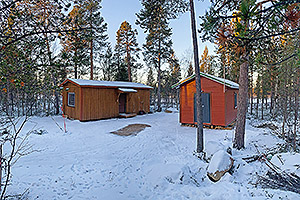
The Aihkiniemi DX base in November 2020 (click
to enlarge photos) |
Imagine spending a week in the
middle of nowhere with 14 Beverage antennas —
each roughly a kilometer in length and capable of
hearing hundreds of rare stations. It's possible
because we've made our famous AM DXpedition base
in Aihkiniemi, Finland, available also for other
DXers to rent. In 2020 both the premises and the
antennas were upgraded, so DXing in Lapland has
become easier than ever before.
Featured
recently even on the
BBC, Aihkiniemi became the first ever purpose-built
AM DXpedition base in Scandinavia in 2010. Most
of the construction work was done in the summer
of 2010, but both the first cabin as well as the
antennas have been improved continuously since then.
The biggest upgrade took place in 2020 when a second
building was added.
We want
you to succeed and we'll do everything to make your
DXpedition as comfortable and successful as possible.
Visiting Aihkiniemi is as easy and as memorable
as a DXpedition can be, because we've already made
the investments and done the hard work for you.
Forget the drudgery of spending days setting up
the antennas and get right into the business of
unforgettable AM DXing!
Antennas
and Equipment
Below are the directions of each
antenna and their intended target areas (updated
in January 2023):
| Beverage
Antennas in Aihkiniemi |
| 207° |
Nigeria
& Western Africa, Italy, Greece, Netherlands,
east coast of Spain, potentially Gibraltar |
| 256° |
Spain, U.K.,
Brazil, Argentina, Uruguay, Paraguay |
| 272° |
Peru,
Bolivia, Chile, Eastern Caribbean (and lower
AM band Argentina, Paraguay, Brazil) |
| 291° |
Florida, Newfoundland,
Cuba, Puerto Rico, Central America, Colombia,
Venezuela, Ecuador |
| 305° |
North America:
East Coast, Great Lakes, Midwest, Mexico |
| 321° |
North America:
Prairie states, Rocky Mountains, Western Mexico |
| 334° |
North America:
West Coast |
| 10° |
Alaska, Hawaii,
part of Kiribati |
| 29° |
The Pacific,
New Zealand (North Island) |
| 45° |
Hokkaido,
New Zealand (South Island), Queensland |
| 63° |
Siberia,
Japan, Koreas, Northern and Eastern China, East
Coast of Australia |
| 82° |
Western
and Southern China, South-East Asia, Central
and Western Australia |
| 94° |
India,
Pakistan, Thailand, rest of South Asia, Western
Australia |
| 162° |
Iran,
the Middle East, Eastern and Southern Africa,
The Indian Ocean islands |
Antenna lengths vary from 800
to 1,200 meters. As you can imagine, Beverage antennas
of this length are very directional on the AM band,
so during good conditions you have to choose what
you want to focus on. The same antennas can also
be used for shortwave listening. Below is our aerial
setup on a Great Circle Map (click for a larger
version).
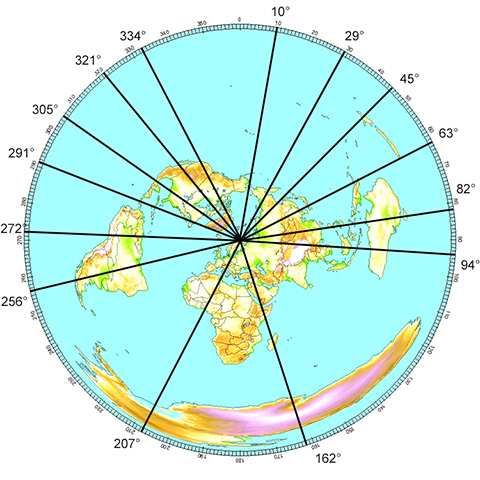
The antennas from 256° to
45° are spread out on the northwestern side
of the main road on a flat but otherwise very challenging
terrain with forest, dense brush vegetation, small
lakes and swamps. The rest of the antennas are located
on the southeastern side of the road in a bit hillier
terrain where the forest is easier to walk in.
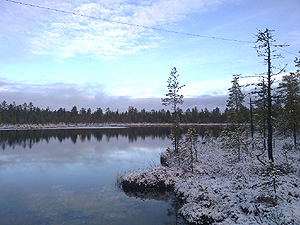
The antennas are hung a few meters off the ground.
|
The antennas hang 3–5
meters above the ground to prevent reindeer and
moose from getting stuck in the wires. You should
inspect all of the antennas at least once during
your DXpedition week to clean them from snow and
ice, and to make sure that the wires are sufficiently
off the ground, and place additional sticks to lift
low-lying wires, where necessary. Having a reindeer
hanging in a low-lying wire would be a nightmare
scenario, in terms of our community relations, something
we need to avoid at all costs. We have a rowboat
to take you over the tiny lake, or you can get to
the other side using a small bridge a few hundred
meters away downstream. In the winter we normally
just walk across the ice, although it can be treacherous.
Once you've made a reservation,
we'll email you a detailed manual, including a map
of the antennas, and the surroundings of the cabin.
We recommend downloading a map software in your
cell phone to keep you from getting lost. Karttaselain
is the best such software, and has a free version
with limited features.
You'll also get more detailed
information on the type of connectors used and answers
to any housekeeping questions you may have. All
antennas are grounded and fed into an impedance
transformer, from which a coax cable leads into
the cabin. Inside the cabin, all coax wires are
HFX50, which is more resilient towards radio-frequency
interference (RFI) than the common RG58. One of
the antennas (321 degrees) is equipped with a toroid-based
RF choke. Inside the cabin, you'll need to handle
the coax connectors very gently. Rough handling
and unnecessary plugging/unplugging of the cables
can cause a major headache to the following crew.
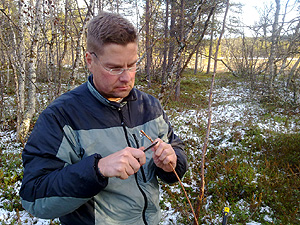
Jim Solatie peeling copper for grounding. |
Please note that this is wilderness
and things happen. Although we work on it year-round,
we can't guarantee that all of the antennas will
be in working condition when you arrive. Bears,
moose, reindeer and rabbits have all wreaked havoc
with our antennas at some point (mostly cutting
or damaging the coax cables on the ground). If you
encounter problems, please let us know so that we
can fix it as soon as one of us has an opportunity
to travel north. Even if a couple of the antennas
are out of service — and you can't find a way
to fix them — there's still an abundant array
of wires that will keep you busy DXing.
The cabin is equipped with an excellent ground wire
that should be used to ground also the antenna switcher.
There's also a grounding panel where all unused
antennas can be attached to reduce interference.
To minimize RFI, there are currently several laboratory-grade
power supplies for your laptop computers and external
hard drives. However, using hard drives which are
powered via USB is recommended to eliminate one
potential source of RFI. Because the level of electromagnetic
interference in Aihkiniemi is extremely low, you
may notice that some of your own equipment cause
RFI which you haven't been able to detect at home.
There is also a separate power
supply to provide 5V DC for a total of four Perseus
receivers. Several old laptops are available for
DXing, but they must NOT be connected to the Internet.
If you're using the internet or wish to use your
favorite pre-installed SDR software, bring your
own laptop(s) with power cords.
You will also find a MiniVNA
which you can use to analyze antenna performance.
Additionally, we have splitters to give both listeners
access to the full array of antennas, but you should
bring your own preamp if you wish to use one. Preamps
are recommended, because there are very few AM stations
in northern Europe, and you can usually boost the
signal without overloading a decent communications
receiver.
What can you expect to hear?
If you've never experienced a
DXpedition in Lapland before, the AM band may initially
sound confusing. It's very different from Central
Europe, for instance. You're likely to enjoy a very
undisturbed band and be impressed by the multitude
of far-away stations both in the morning and afternoon.
On the other hand, a location in the far north means
that the AM band can become almost dead silent during
a solar storm. In any case, you're in for a lot
of surprises, and conditions are likely to change
from day to day. A week should provide enough time
to overcome a solar storm and still enjoy some decent
conditions at some point of the week, which is why
we wouldn't recommend going through the trouble
of traveling up there for only a weekend or so.
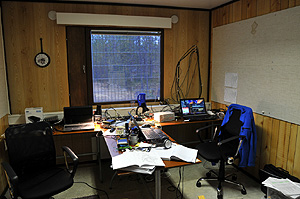
The DXing room has enough space for two DXers
at a time. |
The main target areas in this
Arctic location are the Americas, the Pacific, the
Far East and Southeast Asia, but of course hundreds
of AM stations from Europe and the Middle East are
also audible. The following is a review of what
you can expect to hear during a typical 24-hour
cycle under average conditions.
Most listeners travel to Lapland
taking the overnight train, so a new crew normally
arrives in Aihkiniemi at the earliest around 2 p.m.
(on a Saturday which is when a weekly reservation
begins and ends), by which time the previous crew
has already left to catch the evening train. Setting
up your gear will take some time, but during the
first day you'll still have time to get a taste
of the Eastern Hemisphere.
From November to February, the
first stations from the Far East can appear as early
as 0900–1000
UTC, and Asian stations can be enjoyed until around
1400–1700 UTC,
when stations from the Middle East and Europe gradually
take over the AM band. Be alert for local breaks,
such as NHK2 station identifications at closing
time (often at 1540 UTC). Indian stations can be
best identified around sign-off time at 1740 UTC
or after 0023 UTC sign-on.
Sub-Saharan AM stations are notoriously
difficult catches because Central European stations
tend to dominate the same frequencies. Our extensive
antenna farm is not very helpful because European
stations are in the same direction, so don't count
on getting many African stations, except in the
case of solar storms. Your best shot to catch sub-Saharan
African stations is to watch for Ethiopian stations
signing off after 2100 UTC; Nigerian, Mozambican
and others signing off around 2000–2300
UTC, and stations from Mozambique, Sudan and Ethiopia
signing on around 0300 UTC. Nigerian stations can
also be heard on the 207-degree wire when they sign
on around 0400–0500
UTC.
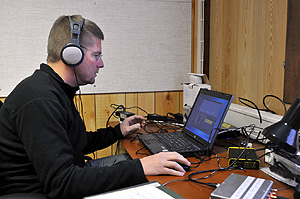
Jim is hunting for new AM stations. |
The first signals from the Americas
appear around 2000–2200
UTC. They're usually from Newfoundland, Venezuela
or northeastern Brazil, depending on the direction
of the conditions. Gradually targets from further
west appear on the dial. Overnight conditions vary
a lot, but the peak listening time to the Western
Hemisphere falls after sunrise Finnish time, around
0600–1000 UTC.
If conditions are good, stations can be heard at
almost every 10 kHz throughout the AM band. A true
feast! Even during poor conditions there's usually
a short peak in conditions at daybreak.
In midwinter, the sun remains
below the horizon, but DXing conditions are similar.
During good conditions, North American stations
from the West Coast can be heard until 1500–1600
UTC, and Alaskan stations even later. Strong signals
from Alaska will give you chills (see a video
of a bandscan of Alaskan and Hawaiian stations).
Around midday Finnish time is
the best time to hunt for stations in the Pacific,
which tend to be overcome by Asian stations later
in the afternoon. Southern Pacific is on the opposite
side of the world, so it is a rare treat, with Tonga
on 1017 kHz being the most common catch.
During less than ideal conditions,
the AM band can be completely silent for hours during
daylight hours. Take it as a good opportunity to
get some exercise, check the antennas and enjoy
the Arctic nature. On Mika's
YouTube channel you can find drone videos of
the landscape around Aihkiniemi. During very severe
solar storms, transatlantic signals can become inaudible
for days.
If you're interested in European
stations, the morning hours around 0500–0800
UTC are best for Spain and the U.K., which have
loads of local stations. They can also be heard
in the evening hours.
So when do you sleep if interesting
stations are heard 24/7? We usually sleep from around
midnight (2200 UTC) to around 07:00 local time (0500
UTC). In the SDR era it is easy to let automated
recordings take care of the overnight period, but
you still need to choose carefully which antennas
to use, depending on the propagation conditions.
The most interesting DX sessions are after sunrise
and before sunset, which need to be monitored carefully.
Midday tends to be very rewarding at midwinter.

The bedroom of the old cabin sleeps two comfortably,
but the new cabin also has one bed. |
How many new AM stations are
you going to catch during one week in Aihkiniemi?
It is difficult to predict, as it all depends on
your experience, persistence, equipment, the solar
weather, and pure luck. We'd say that if you haven't
visited a Scandinavian DXpedition base before, if
you are equipped with an SDR receiver capable of
recording the entire AM band, and your week happens
to be average in terms of reception conditions,
you can expect to record hundreds of new stations.
Even though we've been on dozens of DXpeditions
in Lapland, we'd still expect an average week in
Aihkiniemi to yield around 50–100
AM stations that we have never heard before. For
examples of what can be heard in Aihkiniemi, check
out reports of recent DXpeditions in Aihkiniemi
(links can be found in the upper right corrner of
this page).
Accommodation and Amenities

Kitchenette in the main cabin |
For the first ten years the Aihkiniemi
DX base consisted of one 30 m² building, which
has two rooms: one for sleeping and the other for
cooking and DXing. There are two beds, so the cabin
was comfortably able to accommodate two DXers at
a time. Back then Aihkiniemi didn't have a water
supply, which was a bit problematic, as we had to
drive to a nearby motel or a camping area for a
shower — and had to pay extra for it. This
is now history.
The first cabin is still the
DX headquarters. However, in August 2020 a second
20 m² cabin was added. This building consists
of a sauna (with an electric stove), a kitchenette,
a small dining area, and a bunk bed (from fall of
2022) for sleeping. A well was built just outside
the cabin, so now you can take a shower in the sauna,
and we don't need to rely on outside services anymore.
Having the second building makes sleeping arrangements
easier as well. An ideal crew consists of two DXers,
and now both can have private sleeping quarters.
No more issues with snoring. Up to four people can
stay overnight, if necessary, but the DX room only
has space for two listeners.
Between the two rooms of the
main cabin there is an indoor composting toilet,
which is odorless. Two doors separate the bedroom
and DXing room, so any DXing/cooking activities
will not disturb the sleepier one too much, although
earplugs are still a good idea.
The old kitchenette includes some closet space,
a microwave oven, a coffee maker, a water heater,
a fridge with a freezer compartment.
The newer building has a second
small kitchenette, with more table space and a larger
fridge, so you can easily store food for two people
to last a one or two-week DXpedition. Both cabins
have electrical heating and are warm even when it's
extremely cold outside.
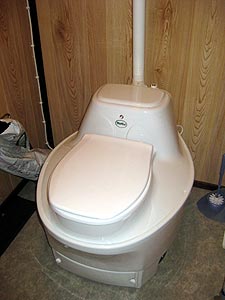
Composting toilet |
The well water has been professionally
analyzed in 2020, and was found to be good drinking
water.
If you need a break from DXing
or a change of scenery, there's a modest motel called
Matkapaikka
Jounila (5 km to the southwest), which offers
lodge-type accommodation. For an off-season fee
of 15 euros/person/visit you can take a shower,
wash your dishes, and watch TV, but not stay overnight.
Then again, all of this can be done at our cabin,
so why pay for it. Another alternative is to drive
a bit longer up the road towards the Norwegian border.
Reino Fofonoff, the owner of Nitsijärvi Cabins,
can arrange for a hot shower or a lakeside sauna
during the fall. Nitsijärvi Cabins has an English-language
website
with detailed instructions on how to get there.
The old Aihkiniemi cabin has a smoke detector and
a fire extinguisher. Please make sure that they
are never needed. Smoking inside is strictly forbidden.
Please, no pets.
There's no closet space
for your stuff, so you'll have to pile most of it
on the floor and tables, or just keep it in your
luggage.
You may find it surprising, but there's good cell
phone coverage even in the middle of nowhere. Carry
your cell phone when checking the antennas or walking
in the forest in case you get lost or hurt yourself.
Be sure to check that your cell phone operator has
roaming agreements with the major Finnish operators,
or get a prepaid SIM card on arrival in Finland.
Airtime and data are very cheap in Finland. We also
have a fast internet connection over a Wi-fi network
in the cabin, with speeds up to 50 Mbps, free for
you to use.
Instructions for obtaining the key will be given
to you after reservation.
Directions
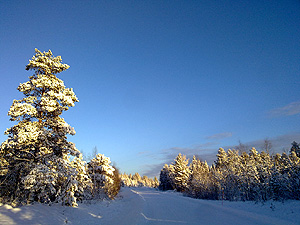
Road number 971 near Aihkiniemi |
We recommend that you fly first
to Helsinki and then to Ivalo. From there, you can
rent a car and drive to Aihkiniemi in two hours.
Alternatively, if you don't mind the extra driving,
you can fly to Kittilä (a ski resort in northwestern
Lapland), Rovaniemi (on the Arctic Circle) or Oulu
(an IT industry boomtown further south) and drive
from there. Finnair
is currently the only airliner with daily flights
to these destinations. Norwegian
flies less often from Helsinki to Rovaniemi and
Kittilä, but has no flights to Ivalo.
All COVID-19 restrictions are
now (in January 2023) history in Finland, so tests
or vaccination certificates are no longer required
on arrival. If the pandemic situation changes, check
out what the Finnish
Foreign Ministry instructs about entering Finland.
If you have more stuff than you can take along in
a plane, and you have more time, you can take an
overnight train from Helsinki to either Rovaniemi
or Kolari (the northernmost railroad stations),
and rent a car for the rest of the journey. You
can check the schedules and purchase tickets from
the national railroad operator VR online.
Of the two northern destinations, driving time from
Rovaniemi is shorter and also the road is better
than from Kolari.

The Ivalo
airport is located 8 kilometers south from Ivalo
downtown. Ivalo is the best place to shop for groceries,
for winter clothing if you need it, and the last
point where you can find a liquor store (Alko).
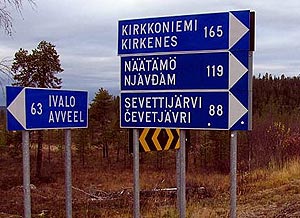
At this intersection you leave the main road
(4/E75), and turn right on road 971. Still 43
kilometers to Aihkiniemi. |
From Ivalo, drive north along
highway 4 (also known as E75), through Inari until
almost Kaamanen. After 63 kilometers, you'll come
to an intersection pointing to Kirkkoniemi, Näätämö
and Sevettijärvi. Turn right on the road "Sevettijärventie"
(road number 971). From this point on there are
no services, so be sure you have all the food and
gas that you need. The road becomes narrower, and
you'll need to be very careful with oncoming traffic.
You will get more detailed driving instructions
after your reservation.
In case you've ever wondered
why many signs in Finland have two versions of each
place name: the one on top is in the dominant language
spoken in the area — most often Finnish —
and the one on the bottom is the minority language.
In southern coastal areas, it's often Swedish. In
Lapland, it's one of the three dialects of Sami,
which is the native language for a few thousand
people in Finland.
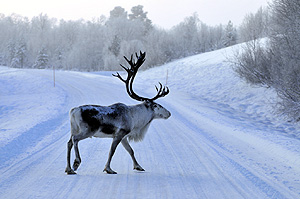
Wild encounters |
If you arrive in
winter, there'll be some snow on the driveway of
the cabin, so drive carefully. The main road is
kept in good driving condition throughout the winter.
You're guaranteed to see reindeer on the road at
some point, so drive with caution. Hitting a reindeer
is only lethal to the reindeer, but there are also
tall moose, which can come through the windshield
if you happen to drive into one. All public roads
in Lapland are open throughout the winter and are
well kept, but they will still be icy and snowy.
What do you need to bring
along?
While we have the antennas, you'll
need to bring your own receiver(s), power cables
and other cables, an antenna selector, and a preamp/amplifier.
A splitter without an amplifier is available in
the cabin. You'll probably also need earphones,
and loads of external hard drives to store your
catches.
A compass and a GPS, USB wires, etc. can come in
handy. It wouldn't hurt to have basic tools to fix
coax connections and antennas, although some tools
can be found in the cabin. The environment is largely
free of interference, and the most likely sources
of unwanted sounds on the dial will be your own
power sources.
Check out the Finnish
plugs beforehand, because you may need to bring
along shape adapters or even voltage transformers
(for 230V). You won't find them in the grocery stores
in Lapland.
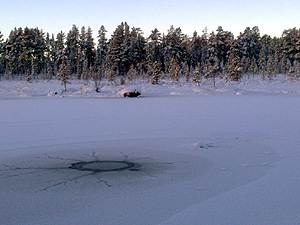
The small lake next to the cabin may look like
it's frozen, but it is essentially a slow-moving
river, so find a narrow and shallow part to
cross, look for the most solid ice, or use a
bridge further downstream. We have a rowboat
that can be used until October. |
Although you'll find mattresses,
pillows and blankets in the cabin, you'll need to
bring your own sheets, pillow cases and towels.
There's also a vacuum cleaner. You're expected to
clean after yourself, unless maybe you're traveling
with your mother... no maid service within at least
100 kilometers ;)
There'll be snow — lots of it. And it'll be
cold. In terms of outdoor clothing, be prepared
for any kind of weather. The temperature can vary
between freezing point and minus 40 degrees, even
lower. Rubber boots or other water-resistant winter
boots are a good idea unless you visit in February
when everything is frozen solid.
Power outages are rare and short,
but bringing a headlamp is still a good idea, because
it will be dark outside most of the time. Two UPS
units with four power outlets each are available
in the cabin to enable you to continue DXing even
in case the power goes out. Plan carefully in advance
for what you might need. Remember, it's a long drive
to the nearest store, especially for toilet paper
— which is why we store a lot of it in the
cabin.
Supermarkets in Ivalo are large, well-equipped and
accept major credit cards. There are smaller grocery
stores in Inari and a tiny one in Kaamanen. ATMs
can be found both in Ivalo and Inari. The nearest
library with free Internet access is in Inari.
If you have used any of the pans, pots or kitchen
utensils, please boil water and do the dishes before
you leave. It can be a bit cumbersome. Alternatively,
you can buy paper plates, cups, and utensils on
your way to the cabin. In any case, please clean
the kitchenettes. When you leave, please take all
your trash with you. You can drop it off at large
roadside bins, the nearest one of which is located
in Käyräniemi
close to Matkapaikka Jounila.
Reservations
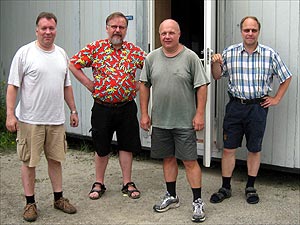
Half of the original Aihkiniemi team, from left
to right Jari, Lauri, Jarmo and Olli. |
Most likely September and October
are booked solid by us, and openings can generally
be found from mid-November. Contact Mika
Mäkeläinen to ask about availability.
If you haven't been to Aihkiniemi before, we require
that during your first week you're accompanied by
someone who has previous experience DXing in Aihkiniemi.
This is to ensure that everyone knows exactly how
things operate, that mainentance standards are upheld,
and that you learn how to get the most out of your
DXing with the resources we have.
The rent for the cabin and antennas is 800 euros
a week. If there are two DXers, it comes to
400 euros per person. The rent must be paid in
advance: The first 200 euros at the time of the
reservation into our association's bank account,
and the rest one month before your DXpedition. Your
reservation is confirmed once we have received your
first payment.
What to do in addition to
DXing?
You might want to consider combining
your DXpedition with a more traditional vacation
trip in Finland. Saariselkä,
one of the largest ski resorts in Finland, is located
just south of the Ivalo airport. So, if propagation
conditions happen to be exceptionally poor, you
can take advantage of the slopes, relax in a spa,
or enjoy after-ski partying. For something cheaper,
but equally impressive, you can watch the aurora
borealis, the northern lights! Further south, you
can meet Santa Claus in Rovaniemi or cruise on an
icebreaker
in Kemi.
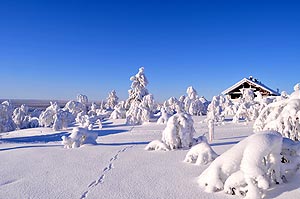
This is what Saariselkä looks like in the
winter, so don't spend all of your trip just
DXing. |
For more information about visiting
Finland, check out the Finnish Tourist Board website,
especially about Lapland.
Compared to most destinations, Finland is very safe,
clean and organized, so even if midwinter is weather-wise
not the ideal time to come over, it is still an
opportunity not to be missed. The capital, Helsinki,
has loads of sights that you can experience year-round,
from modern architecture, opera and dozens of museums,
to nightlife and gourmet dining.
In case you happen to be traveling
in Lapland during the summer, you can rent the Aihkiniemi
cabin for any period of time for 50 euros per night.
It's a good base for exploring Lapland, and in the
summer you can enjoy 24 hours of daylight, which
is an experience in itself. There are ample opportunities
for fishing, hiking, and picking wild berries as
well as mushrooms (which you can do even without
landowner's permission). In Lapland you can even
try your luck in gold-panning.
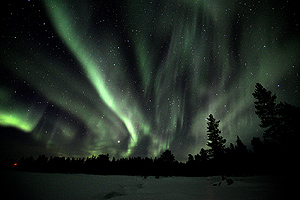
Weather permitting, northern
lights can usually be seen several times each
week. This shot is from Aihkiniemi. |
We own fishing rights in some
areas of the surrounding wilderness, so when you
rent the cabin, you can fish in these areas. And
we have lots of coveted cloudberries in and around
our property in early August. As for your luggage
— add mosquito repellent and forget your radio
equipment; there's not much to listen to on the
AM band in mid-summer. The AM season extends from
early September to April, but in the future there
will also be an FM antenna in Aihkiniemi. More about
this later.
In Finland most people understand English well enough
to be able to help you, so getting around and finding
what you need is easy. Be in touch if there's anything
more that we can help you with in preparing your
DX vacation of a lifetime. Welcome to our paradise!
| Jorma
Huuhtanen, Markku Jussila, Martti Karimies,
Mika Mäkeläinen, Lauri Niemi, Jarmo
Salmi, Jari Sinisalo and Jim Solatie |
Published
on May 25, 2011 (last update in January 2023)
  
|